BY DANNY MORAN
A wise man once said, “Stretching and advancing the initial attack line is the most fundamental and important task an engine company has to perform.” That wise man was the late Fire Department of New York Lieutenant Andrew A. Fredericks. This lesson from our past still holds true today and should never be forgotten. As firefighters, it is our nature to be proactive when it comes to many areas of our lives. We can come up with a predetermined plan for just about anything and then be ready with a backup plan. The same must hold true for stretching and advancing hoselines, especially the initial attack line. How and where the line is stretched will make or break the battle against a growing fire.
One aspect of our lives when it comes to firefighting that is always consistent is the use of the preconnected hoseline. Preconnects sure do see a lot of fire, don’t they? But what happens when that predetermined length of hose comes up short of where it needs to be? Are you ready with a plan to rapidly extend the line, or do you already know ahead of time that this fire is beyond the reach of your preconnect? Remember, a fire in an enclosed compartment has the potential to double in size every 30 seconds. Therefore, we cannot afford mistakes such as misjudging hose lengths and allowing the fire to intensify. By getting out in your first-due territory and preplanning with the members of your fire station, you will “know before you go.”
NEW BUILDINGS, NEW MINDSET
Although the figures vary throughout the country, it’s a fair bet that 60 to 70 percent of the time, most of us are responding to some sort of medical emergency. The number of structure fire responses has decreased over the past 40 years. Firefighters from the 1970s through the 1990s fought a lot of fire, garnering a tremendous amount of knowledge and skill directly attributable to the sheer number of fire-related incidents of their generation. It is imperative that we listen to and learn from these firefighters’ real life experiences before they take their knowledge into retirement.
A current trend in today’s fire service is to seek knowledge and learn skills through a lot of training. Remember, statistics prove that although the annual number of structure fires has significantly decreased, the firefighter death rate at structure fires has not dropped much at all, so firefighters should always strive to be students of the profession no matter how much time they have on the job. Complacency opens the door for a multitude of problems. Don’t let it sneak into your firehouse. Two of the most important things I’ve learned in my career are (1) Don’t accept complacency, and (2) the initial attack line’s stretch and advance are important. Fredericks emphasized that for the engine company, the initial stretch is a fundamental and crucial task.
In my first-due territory, as in many areas across the country, old rundown buildings are coming down and making way for new residential structures, often garden apartment complexes. As they go up, we need to consider the stretching and advancing of initial attack lines. If we become complacent and rely on the preconnected hosebed for just about any fire, we will eventually stretch short and possibly set up our companies for failure. New buildings demand new tactics, and more often we are seeing buildings that require a longer stretch, beyond that of preconnects. Today’s firefighters need to always think about how they will stretch and advance hose across large courtyards and to the upper levels of multiple-family dwellings.
To cut down on cost, many of the new apartment complexes are low-rise buildings that are not equipped with a standpipe. A three-story multiple-family dwelling with no standpipe set around a large courtyard can present many challenges to an unprepared first-arriving engine company. Where is the fire, and how are we going to access the fire room? What hose are we going to deploy? Do we need appliances or our high-rise packs? Do we need to set up a portable standpipe? Prepare yourself for these and other out-of-the-ordinary stretches, because as the old adage says, “As the first line goes, so does the fire.” At a recent training event, I heard someone say, “You could be a very knowledgeable officer, but if your crew cannot stretch a line, you have failed.” This is absolutely true. Prepare and train on stretches beyond the preconnect.
PROACTIVE VS. REACTIVE
The proactive firefighter, or most likely fire officer, who makes a decision to stretch the initial attack line already knows how much hose will be needed. That’s because he is constantly estimating the stretch on every out-of-the-ordinary residence, garden apartment building, commercial warehouse, and high-rise building in the first-due territory. We can do this while out in our response district or while clearing an emergency medical service (EMS) run. As my engine company is clearing a medical run, we always talk about where we just were, saying, “Did you notice this? Did you notice that?” A more common question nowadays is, “Do you think we could manage a fire here effectively with our preconnects?” As with many areas of the country, garden apartment complexes and low-rise, multiple-family dwellings with no standpipe are becoming common. The bread-and-butter operation of “stretching on a dwelling” now requires a little more thought about the preconnect.
Being proactive and knowing the answer to that question at 2 p.m. while clearing a medical run will make your engine company look like professionals at 2 a.m. when there’s smoke showing and people are trapped, requiring your company’s best performance.
Professional firefighters always provide the best service available to their citizens. To be professional, we must be proactive, not reactive. Playing catch-up in the above 2 a.m. scenario is a recipe for disaster for your citizens and your company. Getting the initial attack line stretched and advanced to the seat of the fire as quickly and as efficiently as possible should be the basic goal of an engine company; once water is applied to the fire, our problems will dissipate.
I speak for everyone when I say, “I don’t want my engine company ending up on an Internet video looking as if we were unprepared.” At every incident, a cell phone is ready to record your actions, so be ready to perform as you want people to see you.
ESTIMATING THE STRETCH
Know before you go means two things. First, know where you are stretching hose. At a recent incident, we arrived at what appeared to be a single-family dwelling with heavy smoke showing from a side door and a front window. The front window just happened to be right next to the front door. Instead of stretching the line straight to the front door, the disciplined nozzle firefighter waited for direction as to where to stretch the line.
Deciding to mentally slow down and wait for a good size-up before stretching the hoseline paid off. This single-family dwelling was illegally partitioned inside, and the fire was not accessible through the front door. We were not aware of the illegal partition until the crews entered the dwelling.
During size-up, it is very important not to have tunnel vision. Arriving personnel-in particular, the first-arriving company officer-must see the whole picture of what is happening. In this case, with smoke seen at the front door, it is very easy to assume the front door will be the point of entry. However, a disciplined engine company will not commit hose on the fireground until the exact location of the fire is known.
At this fire scene, a resident was outside, waving at the first-due engine company from the side door of the dwelling. He informed the company officer (me) that the only way to get to the fire was through the side door. He stated that there was a wall separating the structure into two dwellings.
If the resident had not been outside to give us this information, the following clues to the fire’s location were visible:
- -The front and a side door were both open. The front door only had light, wispy smoke issuing from the upper part of the doorway. The side door, however, had dark smoke down to the ground billowing out under pressure.
- -An air-conditioning unit was mounted in a window just to the left of the front door, indicating a dividing wall may possibly be by the front door.
- -A double mailbox was mounted right at the front door. Properly placing the initial attack line through the side door ensured a successful firefight.
Imagine how frustrating it would be if you rushed the initial stretch and then the backup line put out your fire.
Second, know how much hose you will need. At another recent incident, crews performed well at a two-story, single-family dwelling set far back from the street. The 200-foot preconnect was stretched to the front door of the residence, and the alert crews realized they did not have at least 50 feet of hose at the front door. It would not have been enough to access the whole residence. Instead of pulling a backup hoseline, the crew called to bring the high-rise hose bundles to the front door and rapidly extended the line. By adding one 75-foot bundle of hose to the operation, the first- and second-arriving crews ensured that the initial attack line was stretched to the proper location and was sufficient to access all areas of the residence.
Remember, the first line is always first. Once the initial stretch is complete and the hoseline is advancing, we can then get a backup line into position. The key to engine company success is staying disciplined to the task of getting the first line in place and quickly and efficiently flowing water. As part of a preplanned fire attack, there are different methods to estimate whether your preconnect will make the stretch or come up short. One way to estimate the distance is to walk from the apparatus to the building counting your steps. Unless your hoseline will be laid out in a direct line from the apparatus to the building, this method will most likely be inaccurate and could cause you to stretch short. Remember, obstacles and corners can take up part of the stretch; you must consider them.
Another way to estimate the stretch is to measure the distance. A measuring wheel will give you an exact distance, since with it you can accurately measure the distance to go around obstacles, around corners, and up or down stairs. One proven way to estimate the stretch is to pull the line and lay it out. A proactive engine company will be able to see exactly how its hoseline will play out around obstacles, corners, stairs, and so forth. Although this is a foolproof method of estimating the stretch, it does come with its own pitfalls. Unless you are out of service while conducting this preplan, you may have to pack up in a hurry to catch another run. It also means that a standard engine company of an officer, a driver, and a firefighter are always stretching and packing hose just to see if the preconnect will make the stretch. This can quickly become labor-intensive for the crew and lead to a disinterest in such preplanning and training.
ESTIMATE-THE-STRETCH ROPE
Another method to estimate the stretch that is not labor-intensive and also can show a crew exactly how its hoseline will play out around obstacles, corners, stairs, and so forth is to use an “estimate-the-stretch” rope to simulate the hose stretch. As shown in photo 1, it simulates the stretch in a hallway. This consists of a bag with 200 feet (the length of preconnects in my department) of rope and a couple of carabiners. We use this rope to estimate our stretches at garden apartments, warehouses, high-rises, and even some single-family dwellings that are set far back from the street. Easily deployed from the bag, the rope gives us a visual of how the hoseline will look when stretched. It also helps us to see where any catch points may be that may snag a coupling (e.g., corners and other obstacles). It answers the question of whether the preconnect will be adequate, and it can be packed up just as quickly as it can be deployed. There’s nothing better than training as we fight-i.e., getting the company together to perform the drill in gear and pull the hose. But in conducting a preplan, my company feels the rope is the way to go so a busy crew doesn’t have to pack up hose in a hurry to respond to another call. It also prevents damage to tile floors from hose couplings (photo 1). Using this rope to preplan hose stretches has great public relations appeal, too. This apartment building’s residents welcomed my engine company and enjoyed seeing their local fire department personnel out conducting such a preplan.
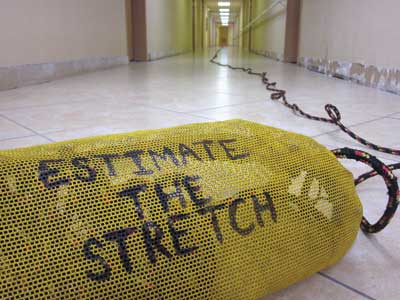 |
| Photos by author. Click to view video |
SUPPLIES NEEDED
To assemble this training tool, you will need the following:
- -One rope bag of any kind. Alternatively, use a five-gallon bucket from a hardware or home-improvement store and cut a hole in the top and in the bottom.
- -Two 100-foot sections of 3⁄8-inch rope. Each section should be a different color.
- -Three carabiners (two small and one large).
- -One eight-foot section of 3⁄8-inch rope. This is the length of my department’s standpipe drop section of 2½-inch hose, which is attached to a pressure gauge and a gated wye.
To assemble this training tool, cut each 100-foot rope section into two 50-foot sections. Next, tie the ends of two ropes of different colors together with a simple figure-eight follow-through knot. This simulates a coupling (photo 2).
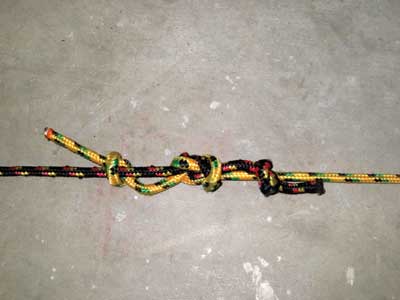
When it is completely assembled and ready to use, you will have 200 feet of rope, tied together in 50-foot sections with a small carabiner at each end, one of which represents the nozzle (photo 3).
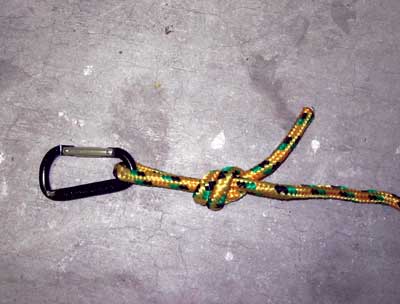
Stretch this rope at a building for which you want to preplan a hose stretch. The alternating colors will allow your crew to visualize each 50-foot section of “hoseline” and the “couplings.” Knowing where each coupling will be in a stretch will help a crew determine where to place members on the line, especially when estimating a stretch up a staircase. Another benefit of seeing the approximate location of each coupling during a stretch is to ensure that you will have at least 50 feet of hose to work with at the door (photo 4).
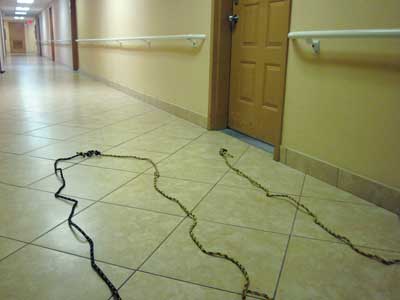
Remember, just because your nozzle can reach the front door does not mean that it will reach the seat of the fire once advanced inside. To make your stretch a success, the advanced line must be able to reach all areas of the structure involved with fire.
Adding the short eight-foot section of rope to this training tool allows my crew to estimate the stretch at high-rises as well. By snapping the eight-foot section to the standpipe in a stairwell using the large carabiner (photo 5), we can determine if our high-rise hose bundles can reach those “top-floor, last-door” fires (photo 6).
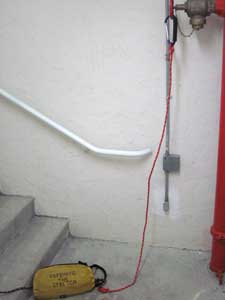
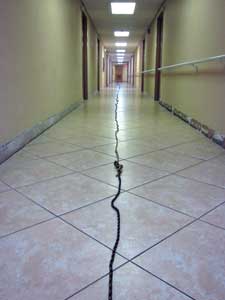
My department’s high-rise hose bundles are two 75-foot sections of 1¾-inch hose and three 50-foot sections of 2½-inch hose. Either way, this gives us 150 feet of hose for high-rise fires. Since our estimate-the-stretch rope is 200 feet long, we can simply untie the last 50-foot section of rope to see just how far our high-rise hose bundles will get us. Remember, the lengths of rope used for this project are equal to lengths of hose carried on my department’s apparatus. If your department varies, then make the adjustments in the numbers to reflect your preconnected hoselines.
As with firefighting operations, stretching and advancing hoselines takes planning, practice, and training. Stretching on a dwelling with just a preconnect is part of any engine company’s bread-and-butter operations. Don’t let complacency sneak into your mindset when it comes to stretching the initial attack line. Preplan your first-due territories. Look at buildings as you drive by and imagine your stretch for these structures. There will be a time when you have a stretch that requires an out-of-the-box decision. Will the preconnect to the front door be sufficient? Will you have to stretch the hose up a staircase? Will you have an extended stretch through a courtyard and use a portable standpipe operation? How many corners or obstacles will the hose have to go around? How many firefighters will be needed to put the initial line into operation? These are questions that you must know the answers to before you respond for a reported fire. Be proactive and preplan, and estimate stretches with this rope, or use whatever method works for you so that you are well-prepared and not surprised if your hose stretch comes up short. An initial stretch that comes up short may just be the first thing that goes wrong in a snowball of events that commonly leads to injuries and line-of-duty deaths. If you fail to preplan, then your preplan is to fail.
Andy Fredericks gave us so many fire service truths that we can all learn from. I learned from his teachings the basics of stretching, advancing, and flowing from the initial attack line. Another great line of his is, “Take the time to make the time.” Taking a few extra moments to think about your plan of attack, slowing down on the fireground, and not becoming complacent will ensure the right hose is deployed to extinguish the fire. This will pay huge dividends in efficiency and the operational safety of crews working on the scene.
The fire service, like all professions, is always evolving and adapting to new technologies. The way we train and operate is becoming more and more advanced. We should regularly practice the fundamentals of stretching and advancing hoselines to reinforce our muscle memory. Knowing beforehand whether these hoselines can effectively reach the fire building’s door and all areas inside is just another advantage that firefighters and fire officers need to have working for them. Lives depend on it!
DANNY MORAN is a lieutenant with the Fort Lauderdale (FL) Fire Department, assigned to Engine 46. A fire service instructor III and a live-fire training instructor at Miami Dade College School of Fire Science, Moran is a hands-on training (HOT) instructor for the Orlando Fire Conference engine company operations class and helps coordinate the Fort Lauderdale Fire Expo, where he is also a HOT instructor. Moran is the president of the South Florida Fraternal Order of Leatherheads Society (FOOLS) and has a bachelor of science degree in criminal justice from Florida International University.
Fire Engineering Archives

